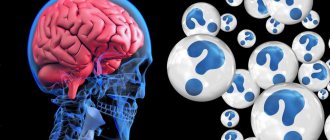Every 10 elderly people are diagnosed with dementia. Moreover, every 10 years this figure doubles as the number of elderly people grows. And in 50%-70% of cases it is associated with Alzheimer's disease1.
Alzheimer's disease is a chronic neurodegenerative disease characterized by the death of nerve cells in the brain. Since the neurons of the brain are destroyed, patients are characterized by disorders of memory and thinking, attention, speech, orientation in space, the ability to make decisions, and perform usual work duties. Mental disorders are expressed by anxiety and depression. In the later stages, intellect and mental activity disintegrate, and in general, motor disorders develop.
The disease is progressing all the time. On average, death occurs 8 years after diagnosis1. A medicine that can prevent the death of brain cells has not yet been invented, so the goal of treatment is to combat symptoms and increase life expectancy.
Kinds
The forms of the disease are divided according to age:
- with early (before 65 years) onset
- with late (after 65 years) onset
- atypical Alzheimer's disease (mixed type with vascular or other problems)
They differ not only in the age of onset of the disease. Often the timing of the onset of the first symptoms of Alzheimer's disease cannot be accurately determined, they are so invisible. It is important that the forms of Alzheimer's disease have significant differences in the clinical picture and features of the development of the disease, this allows for more accurate diagnosis.
Taking stock of forms of dementia and their relationship to Alzheimer's disease
What is the difference between dementia and Alzheimer's disease is an incorrect question. Alzheimer's disease is dementia, a special case. But it has a complex origin, develops against the background of metabolic disorders in the brain, and the hereditary factor also plays an important role. It is unpromising in terms of therapy and cannot be eliminated by any methods.
The above-mentioned features of Alzheimer's disease distinguish it from other forms of dementia. Neither the patient nor the doctors can do anything.
If other types of pathology can be prevented, then the named metabolic form can neither be prevented nor predicted. That's why there are no preventative measures.
All this makes Alzheimer's disease a separate form of dementia, unlike others and unique from the standpoint of science and practice.
Symptoms and signs
Symptoms and signs of Alzheimer's disease vary at different stages of the disease. First, short-term memory and the ability to remember new things are lost. The same questions are asked many times. Then abstract thinking is lost and long-term memory begins to suffer. Words, concepts, names of grandchildren, events of recent years are forgotten. Work tasks become impossible, writing and calculations are disrupted.
In older people, signs of Alzheimer's disease may include problems with mental calculations, forgetfulness, difficulty finding the right words, and handwriting becoming less legible.
In rare cases, the problem occurs before the age of 30, when there is a hereditary predisposition, as well as provoking factors such as diabetes mellitus and traumatic brain injuries. The difference is that the progression is much faster. First, short-term memory is impaired, then it becomes difficult to explain something. It is not always possible to start treatment on time, since Alzheimer's disease at a young age is easily confused with psychiatric diseases.
In women, the disease is more common and develops faster. Damage to nerve cells leads to changes in behavior: passivity, apathy, tearfulness, and frequent mood swings. Since the onset of the disease often coincides with menopause, it is not easy to determine that these are manifestations of Alzheimer's disease.
In men, the disease is diagnosed less frequently. Initial symptoms remain unnoticeable for a long time, and symptoms develop slowly.
Types of dementia and how to distinguish them from Alzheimer's disease
Alzheimer's disease
Alzheimer's disease is a dangerous and irreversible pathological process. Its essence lies in the destruction of brain cells with the loss of higher brain functions. The following features are typical for diagnosis:
- The metabolic origin of the pathology, however, the basis of the disorder is a hereditary factor.
- Prevalence in the epidemiology of the female population. It is women who suffer for the most part. The ratio with men is defined as 4-6:1.
- Inability to cure or slow down the progression of the disorder.
- Absence of immediate risk of death even with complete destruction of personality.
- Slow development.
- Gradual development of the clinical picture.
- Total disorders of higher nervous activity. Intelligence, memory, and behavioral components suffer.
- Formation age: 60+.
You can learn more about this disease from our separate review.
Senile and presenile dementia
Senile dementia is a purely senile disorder. It is popularly called “senility”; this term is not used in medical practice, but reflects the essence of the phenomenon. Character traits:
- Development at the age of 75 and over. With rare exceptions. This selectivity is due to the deterioration of nutrition of cerebral structures and the natural aging of the body.
- There is a natural mechanism for the formation of the problem. There is no primary diagnosis as such, therefore senile dementia is a physiological phenomenon, although it is not the norm.
- Mostly women suffer, however, not in the same combination as with Alzheimer's disease. The proportion is approximately 3:1; representatives of the stronger sex endure the diagnosis more difficult and reach the final state with a pronounced personality defect earlier.
- A cure is still impossible, although there are chances to improve the course and smooth out the clinical picture with medication. There is no risk of death.
- Development is extremely slow. Often, by the time of biological death, the patient is at almost the same “point” in terms of symptoms at which the disruption of brain function began.
The key difference between Alzheimer's disease and senile dementia is its naturalness (relatively speaking) and much less aggressiveness. In addition, formation occurs in much later years. Alzheimer's disease and senile dementia are not the same thing; the senile type is not considered a type of Alzheimer's disease.
As for the presenile variety, it is a clinical variant of Alzheimer's disease. It develops several years after manifestation. The main symptom is speech impairment.
Vascular dementia
This variety develops against the background of insufficient nutrition of the brain. For malformations, aneurysms, congenital and acquired defects of the circulatory system at the local level. Often found in patients with hypertension. Specific features typical of vascular dementia and distinguishing it from Alzheimer's disease:
- Vascular origin. Development is observed due to pathologies of the circulatory system.
- Comparative aggressiveness. The development of the final state takes from 3 to 5 years. Plus or minus. There is a direct relationship between the disorder, the rate of its progression and the primary diagnosis.
- Rapid increase in symptoms. The clinical picture is formed almost instantly.
- There are prospects for cure even at advanced stages. When assessing the likelihood of a cure, you need to pay attention not to the severity of symptoms, but to the state of the brain. If there are no or minimal organic and structural changes, the chances are good.
- There are risks to life. Because the primary disease does not go away.
- Has no age preferences or demographic characteristics.
How to distinguish Alzheimer's disease from vascular dementia?
It is necessary to look at the medical history and also evaluate the condition of the arteries of the brain, the speed and quality of blood flow. Without special diagnostics, it will not be possible to get an answer.
Thought disorder in Parkinson's disease
Parkinsonism is determined by the destruction of the extrapyramidal system. Hence the main characteristics of the pathological process:
- The origin is usually unknown. The root cause may be infections, taking certain medications, or brain injuries. Metabolic disorders are not typical as an etiological factor.
- Mostly men suffer. Ratio 2:1. What this is connected with is not known exactly.
- There are chances for recovery. Specialized drugs are used to combat parkinsonism. They help slow down the progression of the disease and relieve the main symptoms.
- There is a risk of death, but the likelihood of such a complication is extremely low. This usually occurs due to injuries resulting from lack of control of one's own body.
- Development is extremely slow. In some cases, it takes decades for a pronounced symptomatic complex to form.
- The disorder has no age preference.
- As for the symptoms. The basis of the clinic is speech and memory disorders, as well as inhibition and problems with coordination and motor activity. Cognitive and mnestic disorders do not develop at all or have a relatively mild course. This is a key difference between Parkinsonian dementia and Alzheimer's dementia.
With proper therapy, especially with early detection of parkinsonism, it is possible to achieve stable correction and long-term high-quality remission.
Dementia due to multiple sclerosis
Multiple sclerosis is the result of destruction of the special myelin sheath that lines the surface of nerve fibers. It is involved in the transmission of nerve impulses. As the disease develops, the intensity of brain function decreases, as does the speed of signal transmission. Which causes problems in the functioning of the central nervous system.
Dementia due to Alzheimer's disease and dementia resulting from multiple sclerosis have many similarities. At the same time, against the background of the latest diagnosis, the disorder develops many years after the onset of the pathological process. It is accompanied by a host of other symptoms from the nervous system: sensory organs and motor activity are affected. The clinic is more extensive, the pathology is not similar to a purely neurological or psychiatric disease. It is also possible to seriously slow progression for many years, which is impossible to achieve with Alzheimer's disease.
Multiple sclerosis is also relatively easy to diagnose even in the early stages using instrumental methods. While another diagnosis does not provide visual signs of structural changes, the symptomatic complex is already present.
Schizophrenic dementia
As the name suggests, it develops as a defect in schizophrenia. There are a number of specific distinguishing features of the diagnosis:
- The origin is not known for certain. Dementia is the result of schizophrenia, which in turn develops against the background of surges in the level of dopamine and other neurotransmitters (serotonin, norepinephrine). The etiology appears to be biochemical rather than metabolic.
- No preference by gender or age. Everyone suffers. As for schizophrenia itself, it begins in young years, up to 30, while dementia itself can form after a year, two, ten years, etc. It depends on the aggressiveness of the course of the underlying disorder and its specific form (simple and malignant forms of schizophrenia have an initially rapid flow).
- Cure is impossible, but the use of antipsychotics and parallel psychotherapy can slow down the continued development of cognitive impairment. How effective this is also depends on the type of schizophrenia.
- Another typical point is the huge variability of the clinical picture. Symptoms of schizophrenic dementia do not fit into the typical framework as with Alzheimer's disease. Depending on the specific diagnosis, we can talk about a whole group of productive symptoms (hallucinations, pseudohallucinations of various types, delusions) and negative manifestations (autization, speech disorders, higher nervous activity, decreased intelligence, apathy, abulia, and others).
The distinction in this case is not very difficult, especially if the process is sufficiently developed and there is a clear clinical picture.
Toxic damage
As a rule, it is formed as a result of long-term use of certain drugs in large dosages. These include antihypertensives, neuroleptics, other types of psychotropics and some others. Workers of chemical plants suffer a little less often, especially with high concentrations of bromine compounds in the environment, lead, and arsenic. It is relatively easy to distinguish such a process.
There is a clear connection between the trigger and dementia. When the culprit and the patient’s contact with it are eliminated, especially after desintoxication therapy, everything returns to normal and the condition no longer worsens. The clinical picture unfolds gradually, but if you stop the influence of the provoking factor, it stops and begins to regress. Symptoms disappear gradually. Which is unusual for Alzheimer's disease, which moves strictly forward.
There are no age or gender preferences. Because the condition has an externally induced etiology, which is easy to influence even without the involvement of doctors.
Alcoholic dementia
It is a special case of toxic dementia. As in the case of toxic damage, it is possible to stop the progression of the pathological process. Provided that the person gives up alcohol. It is also possible to partially restore higher nervous activity even in later stages. In the early stages, to return to normal, it is enough to eliminate alcohol and undergo a course of treatment. To speed up brain function and restore cerebral blood flow.
As for other factors: there are no age or other demographic preferences for the development of the disorder. Etiology is subjective. The patient is quite capable of correcting the condition himself; as he consumes alcohol, the brain is destroyed, and phenomena similar to those with traumatic brain injury are observed.
The clinical picture of alcoholic dementia is represented by problems with speech, motor activity and thinking. But the ability to think is not completely lost over time, as in Alzheimer's disease. The deviation is fragmentary. Even with personality degradation, at least the ability to speak and basic emotional reactions are preserved. The defect at the final stage does not reach the same depth as in Alzheimer's disease.
Traumatic type of dementia
It is relatively rare. The result of multiple brain injuries, regardless of severity. A particular and most striking representative of this group of diagnoses is boxing dementia. The disease cannot be cured, but it extremely rarely progresses without the influence of an external provoking factor.
- From the moment of development until the patient’s natural death, the clinical picture remains identical or worsens slightly. Provided that the person is not affected by a traumatic factor and the brain is in a state of physical rest.
- The origin is typical - destruction of brain cells as a result of small hemorrhages, their scarring and loss of their own functions. Gradually, an array of such cells accumulates and becomes critical. There are no gender preferences.
- Cure is impossible, but progression is also atypical, therefore it is recommended to take nootropic drugs and cerebrovascular drugs to partially improve thinking functions. Age also doesn't matter.
- The clinic is represented mainly by problems with memory and speech. Depending on the degree of deviation, problems with thinking are observed. From minor to critical if a large volume of brain tissue is destroyed.
Idiopathic form
Although it is classified as a separate category, it is impossible to say anything specific about it. The idiopathic variety is diagnosed in patients when objective studies do not indicate the specific origin of the pathological process. All unclear clinical situations fall here. Therefore, it is impossible to identify typical features.
Epileptic dementia
Despite the name, dementia is not the result of epilepsy itself, but of possible brain injuries or long-term use of drugs to treat a neurological diagnosis. A typical combination of clinical signs of traumatic and toxic (mainly the second) forms of the pathological process. The specificity is determined by the parallel clinical course of epilepsy with convulsions, emotional instability, and, less often, hallucinations.
Diagnostics
Tests
A neurologist or psychiatrist can make the correct diagnosis and identify the initial symptoms of Alzheimer's disease.
Diagnosis of Alzheimer's disease must be comprehensive.
In addition to the usual questioning and examination, psychological tests are used that identify problems with memory and cognitive functions at an early stage.
Examples of tasks:
- draw a clock face with a given time (for example 10.45);
- draw a clock face;
- reproduce a geometric figure from a picture;
- rewrite the sentence;
- read cards with words and then repeat;
- find the given symbol/number in the picture.
It is advisable for every elderly person to undergo testing in order to identify problems at an early stage.
Neuroimaging
Magnetic resonance imaging (MRI), computed tomography (CT), and positron emission tomography (PET) are used. These methods help to see changes in the structure of the brain. The doctor evaluates atrophic changes, the size of the grooves, gyri, and affected areas. Modern research helps to exclude other diseases, such as strokes, tumors, and prescribe the correct treatment.
Genetic testing
Helps to identify a disease with an early onset and aggressive course. Used in the diagnosis of familial forms of Alzheimer's disease.
Laboratory research
Allows you to exclude other diseases with similar symptoms of dementia. An analysis of liver enzymes, assessment of thyroid function, levels of B vitamins, folate, tests for syphilis, HIV, and urine testing are required. Examination of cerebrospinal fluid if a tumor or infection of the central nervous system is suspected.
A detailed analysis and history of the development of symptoms is important; this can increase the accuracy of diagnosing asthma to 90–95%2. It is important to note any new signs in the patient’s behavior. Sometimes this information plays a more important role compared to even CT/MRI studies.
Stages of the disease
Alzheimer's disease develops gradually, not all at once.
"Doubtful" dementia
The early stage may not be noticeable to others and can only be revealed through detailed neurocognitive tests. This stage is characterized by mild forgetfulness and inaccurate memories. You can also notice difficulties in determining the similarities and differences between objects and events. Abstract thinking and planning are difficult. In ordinary life, we won’t even notice this, so a person manages to hide or compensate for small problems in communication and work.
Mild dementia
Memory impairments become more obvious, especially for recent events. A person can get lost and forget his usual route. Confuse the order of events. Cannot find commonality or compare two objects or events. The ability to do calculations and write letters is lost. Such a person will speak slowly, use simple words, sometimes they may not be enough for reasoning. At the same time, the usual self-care activities are preserved.
Changes in behavior are already possible in the form of petty nonsense that someone is stealing from him, oppressing him, or causing harm. The state may be depressed due to the understanding that “something is wrong” with the head.
Moderate dementia
At this stage, learning new information becomes impossible. A person gets confused in the order of important events in his own life. He ceases to understand where he is and what time it is. The stock of memory and knowledge is constantly decreasing, they are becoming more and more inaccurate and blurred. Speech is impaired, first the ability to write is lost, then to read.
A “time shift” into the past may occur in consciousness. A person thinks and perceives everything as if he were not living today, but in a time that he still remembers. This may be accompanied by energy and a persistent desire for pseudo-activity.
Severe dementia
A person completely loses touch with reality, he not only does not orient himself in time and space, but also loses the idea of himself, his personality. Such a person cannot live independently. Attention is very weak. Reactions are more template, “automatic”. At the same time, emotional contact is preserved; an example would be “imaginary” conversations, when the patient tries to maintain a conversation, but its content is completely meaningless. The mood can change from aggression to apathy.
The patient is weakened psychologically and physically. Activity decreases sharply, complications develop in the form of bedsores, pneumonia, which leads to death.
Causes
There are many theories about the occurrence of Alzheimer's disease, but the exact cause has not been established.
The exact cause is still not determined.
Lack of acetylcholine. It was thought that the disease might be related to a deficiency of this neurotransmitter. But it turned out that the administration of this substance does not improve the condition of patients.
Amyloid theory. Amyloid protein is deposited in brain tissue and is detected on CT/MRI in the form of plaques. First, the transmission of nerve impulses is disrupted, then the brain cells die. It can take 10-15 years from the appearance of the first plaques to mild forgetfulness3.
Tau theory. Structural abnormalities occur in the structure of tau protein, which is contained in nerve cells. This disrupts the transmission of nerve impulses, and ultimately leads to the death of the neuron. These disorders are usually detected after the onset of amyloid plaques.
Genetic predisposition becomes the cause in only 10% of cases1.
See, that's what the app is perfect for.
Vascular dementia and Alzheimer's disease differ in that with vascular damage, cognitive impairment can remain stable for a long time, and then there seems to be another jump with a deterioration in the condition. In Alzheimer's disease, constant deterioration can be seen.
Six patients, with an average age of 72 years, were randomly given four weeks of the drug COR388, which inhibits toxic protease proteins produced by the bacteria Porphyromonas gingivalis. The remaining 3 patients received placebo.
The researchers scanned the brains of 162 infants aged 2 to 25 months and conducted a DNA test. A variant of the E4 gene was found in 60 of them, and on MRI their brains were compared with the brains of children in whom this gene was not found. Children with APOE-E4 had more developed brains in the frontal lobe, but development in some areas of the middle and back of the brain lagged behind their peers. The most common cause of CI, accounting for about 60% of all cases of dementia, is Alzheimer's disease (AD), about 10-15% of cases of dementia are caused by cerebrovascular disease (CVD), a combination of cerebrovascular pathology and AD is observed in most cases of dementia [2 ].
The patient may experience various neurological abnormalities caused by multiple foci of replacement of normal nerve cells with connective tissue. Such lesions are called plaques. Both old and fresh plaques may be present at the same time. The size of such plaques ranges from several millimeters to several centimeters; several plaques can grow together into one.
Parfenov Vladimir Anatolievich - Dr. of Sci. (Med), Professor, Head of the Department of Nervous Diseases and Neurosurgery of the Federal State Autonomous Educational Institution of Higher Education First Moscow State Medical University named after IM Sechenov of the Ministry of Health of the Russian Federation (Sechenov University), Director of the Clinic of Nervous Diseases named after AY
Atrophy of the affected areas is more widespread in the temporal and parietal lobes, areas of the frontal cortex and cingulate gyrus.
Memory: severe forgetfulness, current events do not remain in memory, only memories of the most significant events of life are preserved.
So, in one popular medical journal I read: “tobacco smoking has been shown in a number of careful studies to reduce the risk of developing Alzheimer’s disease by 18-22%.”
Alzheimer's disease and Pick's disease are not curable in the full sense of therapy. However, in all cases it is possible to use methods that can significantly improve the general condition of patients. Alzheimer's and Pick's diseases have a more common nature. Both of them entail dementia, which is associated with atrophy. The cause of Pick's disease is destruction and atrophy of the cerebral cortex, which primarily affects the frontal and temporal lobes.
All materials and prices posted on the site are not a public offer, defined by the provisions of Art.
Treatment
Today, treatment for Alzheimer's disease is aimed at combating symptoms and improving the quality of life of patients.
It is important to start treatment in a timely manner!
Cholinesterase inhibitors. The following drugs are used to combat acetylcholine deficiency:
- acetylcholine precursors (citicoline, choline alfoscerate);
- promoting the release of acetylcholine in the synapse (ipidacrine);
- capable of enhancing the effect of acetylcholine (galantamine);
- blocking the breakdown of acetylcholine (rivastigmine, donepezil, galantamine, ipidacrine);
Memantine is the only drug recommended worldwide for the treatment of dementia due to Alzheimer's disease. Can be used for moderate to severe cases.
Cerebrolysin – believed to increase brain cell viability.
All drugs can have significant side effects and have strict contraindications, so the dosage regimen is selected individually by the doctor. It is also impossible to supplement the treatment regimen with nootropics in order to support the brain on your own.












